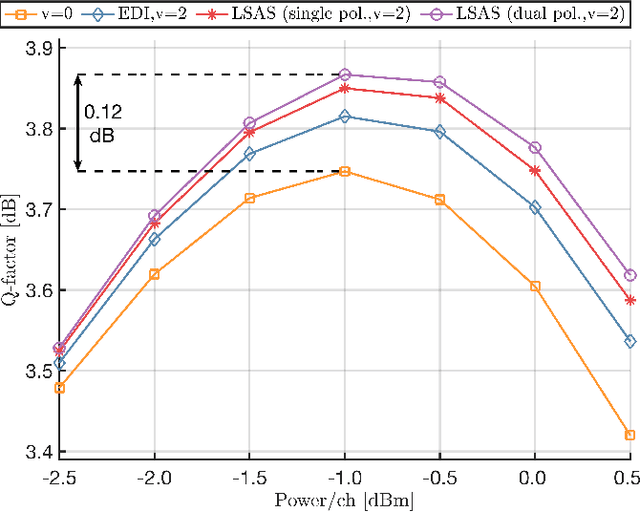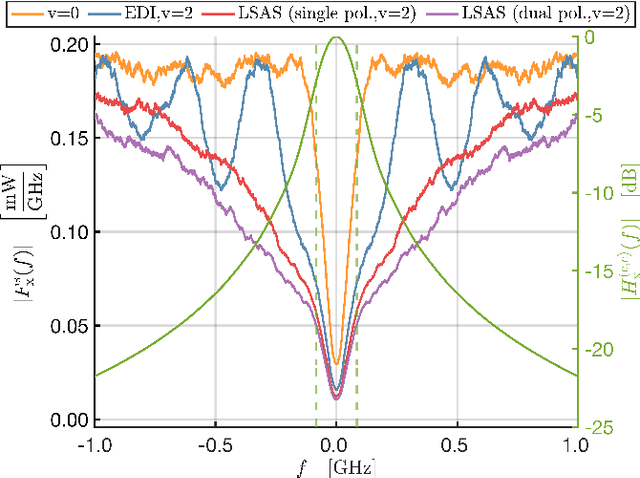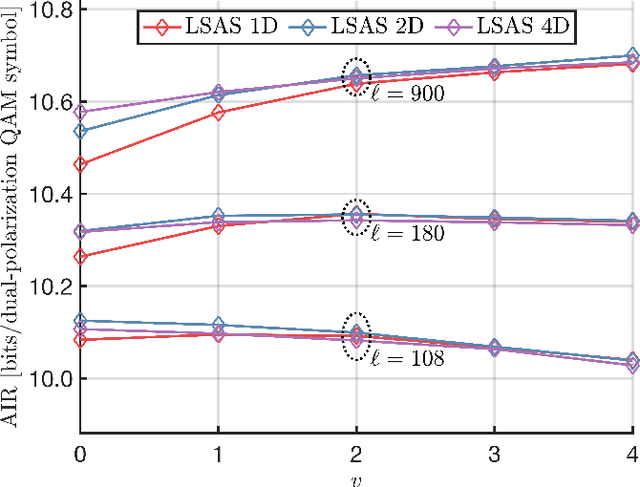Mohammad Taha Askari
Probabilistic Shaping for Nonlinearity Tolerance
Dec 12, 2024Abstract:Optimizing the input probability distribution of a discrete-time channel is a standard step in the information-theoretic analysis of digital communication systems. Nevertheless, many practical communication systems transmit uniformly and independently distributed symbols drawn from regular constellation sets. The introduction of the probabilistic amplitude shaping architecture has renewed interest in using optimized probability distributions, i.e., probabilistic shaping. Traditionally, probabilistic shaping has been employed to reduce the transmit power required for a given information rate over additive noise channels. While this translates into substantive performance gains for optical fiber communication systems, the interaction of shaping and fiber nonlinearity has posed intriguing questions. At first glance, probabilistic shaping seems to exacerbate nonlinear interference noise (NLIN) due to larger higher-order standardized moments. Therefore, the optimization of shaping distributions must differ from those used for linear channels. Secondly, finite-length effects related to the memory of the nonlinear fiber channel have been observed. This suggests that the marginal input-symbol distribution is not the only consideration. This paper provides a tutorial-style discussion of probabilistic shaping for optical fiber communication. Since the distinguishing property of the channel is the signal-dependent NLIN, we speak of probabilistic shaping for nonlinearity tolerance. Our analysis builds on the first-order time-domain perturbation approximation of the nonlinear fiber channel and revisits the notion of linear and nonlinear shaping gain. We largely focus on probabilistic amplitude shaping with popular shaping methods. The concept of shaping via sequence selection is given special consideration, as it inherently optimizes a multivariate distribution for shaped constellations.
Perturbation-based Sequence Selection for Probabilistic Amplitude Shaping
Jul 12, 2024Abstract:We introduce a practical sign-dependent sequence selection metric for probabilistic amplitude shaping and propose a simple method to predict the gains in signal-to-noise ratio (SNR) for sequence selection. The proposed metric provides a $0.5$ dB SNR gain for single-polarized 256-QAM transmission over a long-haul fiber link.
Bayesian Phase Search for Probabilistic Amplitude Shaping
Sep 08, 2023

Abstract:We introduce a Bayesian carrier phase recovery (CPR) algorithm which is robust against low signal-to-noise ratio scenarios. It is therefore effective for phase recovery for probabilistic amplitude shaping (PAS). Results validate that the new algorithm overcomes the degradation experienced by blind phase-search CPR for PAS.
Probabilistic Amplitude Shaping and Nonlinearity Tolerance: Analysis and Sequence Selection Method
Aug 06, 2022



Abstract:Probabilistic amplitude shaping (PAS) is a practical means to achieve a shaping gain in optical fiber communication. However, PAS and shaping in general also affect the signal-dependent generation of nonlinear interference. This provides an opportunity for nonlinearity mitigation through PAS, which is also referred to as a nonlinear shaping gain. In this paper, we introduce a linear lowpass filter model that relates transmitted symbol-energy sequences and nonlinear distortion experienced in an optical fiber channel. Based on this model, we conduct a nonlinearity analysis of PAS with respect to shaping blocklength and mapping strategy. Our model explains results and relationships found in literature and can be used as a design tool for PAS with improved nonlinearity tolerance. We use the model to introduce a new metric for PAS with sequence selection. We perform simulations of selection-based PAS with various amplitude shapers and mapping strategies to demonstrate the effectiveness of the new metric in different optical fiber system scenarios.
 Add to Chrome
Add to Chrome Add to Firefox
Add to Firefox Add to Edge
Add to Edge